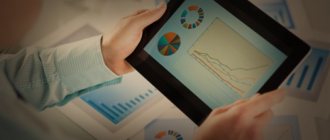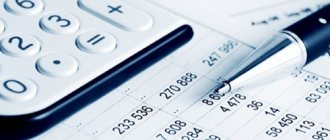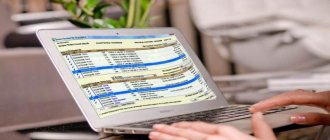Why is account 02 needed?
Fixed assets (PE) are assets that a company uses to produce products or provide services for more than a year.
Depreciation is regularly charged on fixed assets - their cost, as they wear out, is transferred in parts to the cost of goods, work, and services. Most fixed assets are very expensive, so a one-time write-off of the cost as an expense will result in the cost of production being greatly inflated. Account 02 according to the chart of accounts is called “Depreciation of fixed assets”. On it, accountants keep records of accrued depreciation, its increase and decrease, write-off, and through it they register the disposal of fixed assets.
Depreciation and wear should not be confused. Depreciation is accounted for in off-balance sheet account 010, and is accrued at the end of the year for housing stock, housing and communal services, or fixed assets of non-profit organizations.
Explanations for account 02 are given in the chart of accounts approved by Order of the Ministry of Finance dated October 31, 2000 No. 94n.
Liabilities of the enterprise
They characterize the obligations, responsibilities and debts of the enterprise and show where the assets come from.
All the assets that an enterprise owns do not come out of nowhere and do not appear out of nowhere; they arise from certain sources. These sources are liabilities.
Assets are closely interconnected with liabilities; any enterprise simultaneously possesses both. After all, if the organization does not have a liability, then the asset will have nowhere to come from. How to determine what a particular property of an enterprise is? To better understand the difference between a liability and an asset, let's look at a few examples.
Example #1 of the interaction of assets and liabilities
The company purchases a packaging production machine. The machine becomes his asset, that is, the organization’s assets have increased. But the machine did not come out of thin air; it was purchased from a supplier for a certain amount of money. As a result of this purchase, the company incurred a debt to the supplier; this debt will be a liability of this organization.
Purchase of a machine → assets ↑ Debt has arisen to the supplier → liabilities ↑
Moreover, note that assets increased by the same amount as liabilities.
Let's look further. The company paid the supplier money for the machine, how did the ratio of liabilities and assets change?
Debt repaid → liabilities ↓ Cash in the company's current account decreased by the amount of repaid debt → assets ↓
As we can see, as a result of this operation, both liabilities and assets decreased. Moreover, they decreased again by the same amount.
How does depreciation work?
You need to start accruing depreciation from the first day of the month following the day when the fixed asset was accepted for accounting. We accepted the OS in August - we calculate depreciation from September.
Until the useful life expires, accruals cannot be stopped. Suspension of work or cessation of use of equipment is not a reason to stop accrual. Suspension is permitted only for conservation for a period of more than 3 months or for a restoration period of more than 12 months.
Accrual must be stopped from the first day of the month following the one in which the object was written off or its cost was fully paid off. That is, depreciation does not need to be charged on any fully depreciated fixed assets with zero residual value, even if your company continues to use them.
Depreciation for recording is calculated monthly in accordance with the method approved in the accounting policy for individual groups or fixed assets:
- linear;
- reducing balance;
- by the sum of the numbers of years of useful life;
- proportional to production volume.
For any method, the useful life is important - this is the period during which the depreciable object generates income. The organization determines the period when it accepts the asset for accounting. When repairing or improving equipment, the useful life is increased.
Accounting and reporting
Where is depreciation shown on the balance sheet? In fact, it is taken into account in account 02, but is not reflected directly. The parameters of this account are such that it is considered regulating. This means that the account has no independent meaning. This status imposes certain restrictions: the use of material is allowed only if there is data from account 01, that is, the main one. It is on it that you can find what the cost of the object was at the beginning, which was later reduced by the amount of depreciation.
A separate group of assets - intangible - cannot be reflected in account 01; account 04 is intended for it. In general, the logic for calculating and reflecting changes here is similar, and depreciation in the balance sheet is shown by account 05, on which you can see how much depreciation accrued on the funds was. At the same time, it is not possible to directly see depreciation on the balance sheet. The data obtained during accounting calculations is not recorded on its own, since it is necessary to reflect assets on the balance sheet; depreciation is not such, but is important in the formation of costs and determination of costs associated with the production process.
Account 02 - active or passive
Account 02 is classified as passive. This means that the accrual and accumulation of depreciation is reflected on the loan. The reduction or write-off of accrued amounts is carried out by debiting account 02. The account is closed by posting Debit 02 - Credit 01.
Although the account is passive, it is not reflected in sections III-V of the balance sheet, but it participates in the formation of an asset - a line of fixed assets. Let us recall that fixed assets in the balance sheet are reflected at their residual value, that is, they are reduced by the credit balance of account 02.
Keep records of exports and imports in the Kontur.Accounting web service. Simple accounting, payroll and reporting in one service
Enterprise assets
These are all elements of economic wealth that can be used in economic activity as a source of profit.
What does this mean? (click to expand)
First of all, these are movable and immovable property, cash, securities, fixed and production assets, inventories, and accounts receivable. That is, everything with which the enterprise is actively involved with the ultimate goal of making a profit.
Read more in the article: Structure of enterprise assets. On balance. Example
Analytical accounting for account 02
Depreciation is tightly tied to fixed assets, so all analytics for account 02 are built around individual fixed assets inventory objects. They include both the asset itself and all the necessary fixtures and accessories for its functioning.
They keep analytical records in one of three standard documents, which are also used for OS analytics:
- OS object inventory card;
- inventory card for group accounting of OS objects;
- inventory book for accounting of OS objects.
They reflect information about the receipt, movement, disposal, modifications, improvements of fixed assets, and also make entries about depreciation accrued from the beginning of operation.
And why is depreciation needed?
When a decision has been made to classify a certain object as a fixed asset, its value is determined. From quarter to quarter it becomes less by an amount defined as depreciation. Initially, a decision is made for the object on how long the operational period is. Throughout this period, reporting for each new quarter will contain updated indicators of the value of property included in the fixed assets.
Depreciation is calculated regardless of how large the organization's profit or loss is. Key concepts are the duration of the reporting period and the established depreciation rates for a specific fixed asset. But how deductions for depreciation are reflected in the financial statements depends on the method chosen in the accounting policy. Some companies use a linear method of reflecting data, while others have established a write-off of value, depending on the timing, proportional to the volume of goods produced by the company. You can also reduce balances.
Correspondence of account 02 with other accounting accounts
| Account 02 by debit | Account 02 on loan |
| 01 Fixed assets 02 Depreciation 03 Profitable investments in material assets 79 On-farm calculations 83 Additional capital | 02 Depreciation 08 Investments in non-current assets 20 Main production 23 Auxiliary production 25 General production expenses 26 General business expenses 29 Servicing production and facilities 44 Selling expenses 79 On-farm settlements 83 Additional capital 91 Other income and expenses 97 Deferred expenses |
Accounting for equipment requiring installation
In some cases, the customer for the construction or repair of objects requires not only the construction of foundations, walls and ceilings, but also the installation of technical devices for a specific purpose. Such objects are built into specified parts of buildings and premises and, as a rule, are handed over to the customer as part of a single package of work.
To maintain accounting in relation to the objects under consideration, the Chart of Accounts allocates a specialized account 07 “Equipment for installation”. It interacts with many other accounts, including:
- by debit from 08, 76, 91, etc.;
- on a loan from 15, 60, 76, 91, etc.
This account is intended for persons whose activities are related to construction and reconstruction. They take into account various machines and other objects intended for installation in newly created and remodeled buildings. Other legal entities do not keep records of equipment for installation and the movement of corresponding fixed assets in this account.
Such equipment, in particular, includes:
- machines and devices for workshops;
- pilot plants;
- various mechanisms and instruments for laboratories
The main feature of such accounting objects is that they require installation, that is, special actions aimed at installation, connection with the foundation, walls, etc. They include, among other things, various devices installed with the equipment.
On account 08, accounting is maintained for the acquisition of fixed assets that do not require installation.
Standard operations on account 02
Any company has fixed assets - its own or leased. Therefore, almost everyone uses 02 account. There are typical accounting entries that occur most often.
| Wiring | The essence of the operation |
| Dt 02-1 Kt 02-2 | The amounts of depreciation of leased fixed assets that became property are reflected |
| Dt 02 Kt 01 | Depreciation accrued during use is written off |
| Dt 02 Kt 83 | Reduced depreciation as a result of markdown |
| Dt 02 Kt 79 | Reduced depreciation on fixed assets transferred to OP on a separate balance sheet |
| Dt 20 (25, 23, 26, 44, 91) Kt 02 | Accrued depreciation on fixed assets |
| Dt 79 Kt 02 | Depreciation was accrued for fixed assets of a separate division |
| Dt 83 Kt 02 | Increased depreciation as a result of revaluation of fixed assets |
| Dt 91 Kt 02 | Depreciation accrued by the lessor organization on leased fixed assets |
Use the cloud service Kontur.Accounting to automate the calculation and calculation of depreciation. Keep records, submit reports, pay salaries and calculate sick leave - 14 days free for all new users.
We don't miss anything!
Correctly reflected depreciation of fixed assets in the balance sheet allows you to accurately understand how large the organization’s profit is and how large amounts need to be included in the report. This determines what results the financial analysis will show, on the basis of which it will be possible to draw conclusions about the profitability of the enterprise. In addition, it is the depreciation of fixed assets in the balance sheet that is a significant factor. The financial leverage of the organization depends quite heavily on this.
Why is it so important how accurately depreciation is reflected on the balance sheet? The relationship is as follows: balance sheet information allows one to draw conclusions about how solvent the organization is. And it will be correct only if the depreciation in the balance sheet that accompanies the recapitalization of part of the company is correctly entered into the reporting.
Balance sheet liability
The liabilities of the balance sheet reflect the sources of formation of the organization's funds. Liabilities reflect the amounts of the organization's equity capital and its accounts payable (i.e., the organization's debt on loans, borrowings, to suppliers and other counterparties).
The passive consists of three parts:
- capital and reserves;
- long term duties;
- Short-term liabilities.
Capital and reserves are the funds of the organization, that is, authorized capital, profit. Long-term liabilities are the debts of an organization that must be repaid within a period of more than one year. Short-term liabilities are debts that must be repaid within a period of no more than one year.
What costs are classified as deferred expenses?
Costs incurred by the organization in the reporting period, but relating to the following reporting periods, are reflected in the balance sheet in accordance with the conditions for recognition of assets established by regulatory legal acts on accounting, and are subject to write-off in the manner established for writing off the value of assets of this type.
Accounting regulations provide for only two types of costs that should be recognized as deferred expenses:
- costs incurred in connection with upcoming construction work. For example, materials transferred to the construction site;
licensed software (software).
In addition, an organization may recognize deferred expenses in other cases.
This is usually done if none of the Accounting Regulations says how to account for a certain type of expense, but, in the accountant's opinion, these costs should be written off as expenses gradually over several years.
Traditionally, in accounting, costs are taken into account as deferred expenses, which in tax accounting are written off as expenses gradually. These are, for example, costs for product certification and costs for voluntary health insurance (VHI).
Deferred expenses (fbp)
Important
The Russian Ministry of Finance has issued an order that this definition be subject to change. Paragraph 65 shows such expenses in the organization’s balance sheet in accordance with the basic rules for recognizing assets that were established by legal acts according to accounting rules.
Such items must be written off in the order recognized for the relevant asset. However, this does not mean that this item was canceled, since no changes occurred in the chart of accounts, and the “deferred expenses” account still exists.
In addition, the rules according to which this item is taken into account as expenses of the reporting period related to the future have a requirement that remains unchanged. Only the interpretation of this point has changed, but in general the content remains the same.
Deferred expenses are an asset or liability on the balance sheet
Under the Tax Code of the Russian Federation, such expenses are added to other expenses. But these works must be financed with the taxpayer’s own or borrowed funds, but not with budgetary funds or state funds.
Expenses of this kind are recognized in tax reporting from the beginning of the next month in which all work or a certain stage thereof is completed. There is a certain procedure for accounting for such expenses. The display depends on their type:
- In equal parts over 12 months. This includes the costs of prospecting and exploration for mineral resources, as well as the acquisition of certain information from others, as well as from government agencies.
- In equal parts over five years, but not more than the service life itself.
Deferred Expenses (FPR)
- these are costs incurred by the organization in the previous and/or reporting periods, but subject to inclusion in products (works, services) in subsequent periods of the organization’s activities.
Without them, it is impossible to generate income in the future. At the same time, we note that deferred expenses exist only in accounting.
Is deferred expense an asset or a liability?
According to the Regulations that regulate the maintenance of accounting records, assets are recognized as those balance sheet items that imply expenses of the reporting period related to the future. Such changes were first noted in the financial statements for 2011. In addition, the documentation does not contain the wording “deferred expenses”. But, despite this, accountants actively use this phrase in their professional activities.
Let's take a closer look at this issue: with the concept as a whole and the nuances associated with determining the composition and organizing the accounting of such expenses. The legislation approves the following: Previously, expenses incurred in the reporting period were related to subsequent ones and were called expenses that were related to upcoming periods. This law is reflected in paragraph 65 of the Regulations, which regulates accounting at enterprises.
Deferred expenses: accounting rules. deferred expenses and income
A typical inventory count is carried out before the annual report is prepared. Frequency - at least once a year. The Inventory Commission sets the amount classified as RBP.
The established form No. INV-11 is used specifically for these purposes. The document is drawn up in two copies: one for the accounting department, the other for the inventory commission.
The report is drawn up based on the amount of expenses incurred in the reporting period and subject to write-off in the future. It is necessary to indicate the date of actual expenses and the expected date of final settlements, that is, the closure of transactions under the BPR.
Modern accountants use automated data collection systems, including when inventorying deferred expenses, which ensures the delivery of results in the proper form. (40 votes, average: 4.50 out of 5) Loading…
If the period exceeds a calendar year, then it will be displayed in the “non-current assets” line; if it does not exceed, then in the “current assets” line. The expenses under consideration do not include items such as the listed prepayment for the services of other organizations and third-party companies that provide assistance. And also the cost of insurance policies does not apply to such expenses. It is very important to take into account the fact that when a travel company develops a new route, costs are generated that will necessarily apply to expenses in future periods. If we are talking about the amounts spent on buying seats on charters, this is again an advance payment.
Are future expenses an asset or a liability?
According to marketing rules, the longer an advertisement is broadcast, the greater its impact. In our case, sales growth should be expected from April onwards. To avoid distortions in reporting, expenses should be distributed over all months. Correct reflection of the posting requires attributing the amounts spent to BPR in March, and then gradually writing them off as expenses as the advertising is broadcast.
A number of operations, despite the similarity with the requirements of the RBP, cannot be carried out according to the 97th account. Such costs do not include advance payments and prepayments.
These are expenses for which contracts provide for a partial or full refund. These types of contracts include an insurance contract or an order for periodicals. Advances and prepayments are included in accounts receivable - they are not considered typical expenses. From this point of view, it is advisable to reflect them on the 60th or 76th account. Thus, when drawing up and filling out accounting documentation, it is necessary to understand what type of costs these or those deferred expenses belong to; in this case, the entries will not be difficult to record correctly and competently, using one or another account. The accountant must document the validity of attributing various types of costs to BPR. In the balance sheet, such expenses must be reflected in the corresponding asset items. For example, licenses issued for a long period are accounted for as part of inventories and are included in the amount to be reflected in line 1210 of the accounting form.
Tax Code of the Russian Federation In Chapter 25 of the Tax Code there is no concept of “expenses and income of future periods”. However, there is an indication that expenses are shown in the reporting period in which they are incurred.
Their occurrence may be provided for in the terms of various transactions.








